Moniek Bloks's Blog, page 159
December 20, 2020
Empress Hermine – A prisoner of the Russians
Hermine Reuss of Greiz was one of the five daughters of Heinrich XXII, Prince Reuss of Greiz and his wife Princess Ida of Schaumburg-Lippe. Her childhood was overshadowed by the death of her mother in childbirth and the incurable disability of her only brother. A 13-year marriage to Prince Johann Georg of Schönaich-Carolath produced five children before her husband’s death of tuberculosis. However determined never to be married again, Hermine ended up meeting the exiled German Emperor Wilhelm II, and soon fate had other plans.
The book Hermine: An Empress in Exile is available now in the UK and in the US.
This article originally appeared as part of the book tour.
On 4 June 1941, Emperor Wilhelm died in his place of exile in the Netherlands. Unwilling to be buried in Germany if it was not a monarchy – he now rests in a mausoleum in the grounds of Huis Doorn. His widow Hermine decided to return to Silesia and only occasionally returned to Doorn to remember Wilhelm. The estate itself had been inherited by Wilhelm’s eldest son Crown Prince Wilhelm and after the war, it would be seized by the Dutch government as hostile property. Her last stay at Doorn would be in January 1944 for what would have been the Emperor’s 85th birthday.
In August 1943, Hermine’s son Prince Hans Georg was killed in action while serving as a captain in the Second German Army. She wrote to J.B. Kan, the liaison between the Hohenzollern and the Dutch government, “My beloved eldest son Hans-Georg I have given to the Fatherland, he fell in Russia, an endlessly heavy loss for me, as you can imagine.” It was the second child she had to bury – having lost her second-eldest son Prince Georg Wilhelm in a motorcycle accident in 1927.
Hermine was still in Silesia in January 1945 when she was ordered to evacuate by the Wehrmacht. Most of her possessions were lost as she fled to Rossla, where her sister Ida lived, but she surrounded by family again. She had her sister, her daughter Caroline Hermine and the young sons of her daughter Henriette with her at Rossla. She was warned of the coming Russian army by her step-son-in-law Ernest Augustus, Duke of Brunswick but she initially refused to believe it. When the Russians came, Hermine was ordered to report to Torgau camp, but she was soon picked up and taken to a residential area on the outskirts of Frankfurt an der Oder, the Paulinenhof. She was kept under house arrest in an abandoned villa. She was allowed to take walks and returned to the habit she once formed with her husband. She was also allowed to have a radio, and she was allowed to buy newspapers, which were her only connections to the outside world. Eventually, she was reunited with her secretary, who brought her youngest grandson, Franz Friedrich, who had been born in 1944.
In early 1946, a British journalist, who had learned of Hermine’s internment, wrote to the British Foreign Minister Bevin and King George VI. The response was “It is not thought desirable for His Majesty’s Government to take any action in this matter” and “any suggestion that we were hobnobbing with the German royal family would be eagerly seized on by the Russians or anyone else who likes to call us revolutionary.”
Slowly, more and more freedoms were taken from her. A newspaper reported, “She lives in an apartment with six rooms, which she shares with seven other people, including her two-and-half-year-old grandson Franz Friedrich of Prussia, a secretary, a driver and his family, and a Russian who acts as a nanny and a translator. During the interview, she sat on a chaise-longue. She stroked her grandson. The walls of the room were filled with portraits of the deceased former Emperor. The interview took place in the presence of four Russian officers.”
On 5 August 1947, Hermine began to feel tired. A doctor diagnosed purulent tonsillitis and an abscess formed, which the doctor wanted to cut open to help Hermine breathe. However, he did not consider it necessary that she was hospitalised. By 7 August, Hermine’s neck was so swollen that she was no longer able to eat and drink. Breathing suddenly became very hard, and when the doctor finally arrived, there was very little he could do. She died later that same day of a heart attack.
After many attempts to have her body repatriated to the Netherlands to be buried next to Wilhelm, she was eventually interred in the Antique Temple in Potsdam – where coincidentally Wilhelm’s first wife was also buried. Hermine, the Empress in Exile, now lies just steps from the palaces from which she was supposed to reign with her husband.
The post Empress Hermine – A prisoner of the Russians appeared first on History of Royal Women.
Empress Hermine – The exiled Empress and the Führer
Hermine Reuss of Greiz was one of the five daughters of Heinrich XXII, Prince Reuss of Greiz and his wife Princess Ida of Schaumburg-Lippe. Her childhood was overshadowed by the death of her mother in childbirth and the incurable disability of her only brother. A 13-year marriage to Prince Johann Georg of Schönaich-Carolath produced five children before her husband’s death of tuberculosis. However determined never to be married again, Hermine ended up meeting the exiled German Emperor Wilhelm II, and soon fate had other plans.
The book Hermine: An Empress in Exile is available now in the UK and in the US.
This article originally appeared as part of the book tour.
With the rise of National Socialism and Adolf Hitler, Hermine saw an opportunity for herself to become more than an Empress in name. She wanted the restoration of her husband and encouraged the attention of Hermann Göring – a powerful figure in the Nazi party –- who came to Huis Doorn twice. Unlike her husband Emperor Wilhelm, Hermine was allowed to travel into Germany, which she often did. She also had the use of apartments in a former palace in Berlin.
Hermine attended the Nuremberg Rally – the annual rally of the Nazi Party – in 1929 and even showed up uninvited at a party thrown by Adolf Hitler. On 18 November 1931, an intimate dinner with Hermine, Hitler and Göring in the salon of Baroness von Tiele-Winckler was arranged. She managed to charm Hitler, and he was impressed by her commitment. He presented himself to Hermine as the saviour of the nation. Hermine did not leave until 1 in the morning, bedazzled by Hitler.
The Nazi party had seen the benefits of contact with the former German royals, even minor ones, but were becoming more reluctant to entertain that relationship. In 1933, guests gathered at the house of Frau Victoria von Dirksen, a well-known hostess in Berlin. Hermine was the first to arrive, but Adolf Hitler delayed his arrival for another half hour. According to a British newspaper, Adolf Hitler later told her, “No one is more aware of the great merit that the House of Hohenzollern has acquired for the Fatherland, but unfortunately the time is not ripe, in the present moment such a measure will provoke only unrest and turmoil, this attitude we have to take into account in our delicate situation today, has by no means welcomed a sweep of this kind. I can tell Your Imperial Majesty in the strictest confidence that an exceptionally important English agent will inform me even before we have taken the government the English government has been most concerned about any attempt to reintroduce the monarchy in Germany.”
Hermine believed that the monarchist movement was making progress, and she returned from Berlin a happy woman. Reportedly, Nazi-leader Ernst Röhm had said to expect a monarchy by the autumn. Meanwhile, the Emperor wrote,” My return to the throne cannot happen fast enough for her, but we won’t get there with her way. She follows the Nazis and does all she can in Berlin, and in writing from here, which does more damage than good. I try to give her a good example with my reserved attitude. I’ll have them come to me. I will not follow those people. If I am ever able to take up the reins of government again, then providence will take care of it.”
Adolf Hitler continued to send mixed messages as to a possible restoration, and it seems Hermine remained convinced for quite some time. Hermine wrote at the end of 1935, praising Hitler, “One’s heart leaps when one thinks of what the Führer has again given Germany this past year – universal military service!” She added, “God preserve this man whose aims are so very pure!” To an officer, she wrote, “We are all so proud of our new army – what an achievement by the Führer, what a leap over the ditch of the Treaty of Versailles!”
In August 1940, after the invasion of the Netherlands, Hermine sent a telegram to Adolf Hitler proudly announcing the engagement of her daughter Henriette to her step-grandson Prince Karl Franz of Prussia. If she still had any belief of restoration with the help of the Nazis, this surely ended with her husband’s death the following year.
Adolf Hitler was represented at the funeral by the Reichs Commissioner for the Netherlands, Arthur Seyss-Inquart and a wreath, with swastikas, was sent. Hitler had probably wished to attend himself but in the words of the Emperor’s daughter Viktoria Luise, “He wanted to use this opportunity to walk behind the German Kaiser’s coffin in front of whole German people and the world, to show them he is the legitimate successor.”
The post Empress Hermine – The exiled Empress and the Führer appeared first on History of Royal Women.
Empress Hermine – A Quotation Mark Empress
Hermine Reuss of Greiz was one of the five daughters of Heinrich XXII, Prince Reuss of Greiz and his wife Princess Ida of Schaumburg-Lippe. Her childhood was overshadowed by the death of her mother in childbirth and the incurable disability of her only brother. A 13-year marriage to Prince Johann Georg of Schönaich-Carolath produced five children before her husband’s death of tuberculosis. However determined never to be married again, Hermine ended up meeting the exiled German Emperor Wilhelm II, and soon fate had other plans.
The book Hermine: An Empress in Exile is available now in the UK and in the US.
This article originally appeared as part of the book tour.
Even before Hermine had married the exiled German Emperor Wilhelm II, he had decided that no matter what – she would be recognised as Empress, even if just by the family. The Emperor’s physician Alfred Haehner wrote that by “choosing a princess undeniably of the blood” the Emperor’s return to Germany was now assured. “The Princess was entitled to be and would indeed become the Kaiserin.” When asked about Hermine’s future title, Wilhelm answered, “Of course Empress.”
The Emperor’s brother, one of the few family members to attend the wedding, toasted the newlyweds with the words, “I drink to the health of his Majesty the Emperor and King and of Her Majesty the Empress and Queen.” Most of Wilhelm’s family had been against the match, and Wilhelm wanted to make it clear – Hermine was his Empress.
Unlike Wilhelm, who was not allowed to travel to Germany, Hermine was able to travel to Germany, and she often did. However, even in royalist circles, she was not always kindly received. From the society in Berlin, she received the nickname Quotation Mark Empress. Bella Fromm, a Jewish aristocrat whose diary has survived, always wrote of “The Empress” when writing about Hermine. In December 1932, the same Bella Fromm recorded, “The ‘Empress’ had some one hundred thirty guests for tea today at her charity bazaar. Regret about the lost monarchy was frankly stated. Hermine had a rather superior smile on her lips, almost smug. The Doorn household has no doubt that Hitler is going to smooth the path for the Hohenzollern restoration. ‘Her Majesty’ received in black velvet, lavishly trimmed with lace. It trickled down her back on a background of pink chiffon. I was careful to avoid the customary hand kiss when my turn came, as her white kid gloves looked by that time like an ordnance map in white and red from the lipstick of those who kissed before.”
Many around the Emperor believed that Hermine would give up on the marriage once it became clear to her that there would be no restoration and she would never truly be an Empress. The Emperor’s physician Alfred Haehner wrote, “This woman will never accept a life of uncomplaining resignation, she will blame the K[aiser] for the failure of her overweening ambitions… She will not allow the rift to become public… but she will increasingly leave the K[aiser] on his own, go on her travels for longer and more frequently and lead a life wholly in keeping with her own desires.”
In the end, she proved them all wrong. Hermine and Wilhelm were married for almost 20 years until his death in 1941. They never were restored to the throne.
The post Empress Hermine – A Quotation Mark Empress appeared first on History of Royal Women.
Empress Hermine and Emperor Wilhelm II – An unwanted match
Hermine Reuss of Greiz was one of the five daughters of Heinrich XXII, Prince Reuss of Greiz and his wife Princess Ida of Schaumburg-Lippe. Her childhood was overshadowed by the death of her mother in childbirth and the incurable disability of her only brother. A 13-year marriage to Prince Johann Georg of Schönaich-Carolath produced five children before her husband’s death of tuberculosis. However determined never to be married again, Hermine ended up meeting the exiled German Emperor Wilhelm II, and soon fate had other plans.
The book Hermine: An Empress in Exile is available now in the UK and in the US.
This article originally appeared as part of the book tour.
Shortly before Easter 1922, Hermine’s young son Georg Wilhelm learned of the lonely German Emperor in exile, Wilhelm II – and he begged his mother to let him write a letter to the Emperor. Wilhelm was so touched by it that he invited the young boy and his widowed mother, Hermine, to Huis Doorn in the Netherlands, where he lived. Hermine decided to go alone as not to interrupt her son’s studies. It would be their first meeting in nine years. Of their first meeting at Huis Doorn, Hermine wrote, “The Emperor’s hair is snowy white. It was beginning to turn grey when I saw him last. How changed he looks with his beard! The white frame accentuates the spirituality of his features. His carriage is firm and youthful. He does not look like a man who permits fate to bend his back. His Majesty stands before me in a simple field-grey uniform. With native chivalry, he helps me out of the car. Gallantly he kisses my hand and conducts me with elastic steps into his home under alien stars. His Majesty insists on taking me to my room.” The following morning, he presented her with freshly cut roses from his first wife’s rose garden.
Wilhelm found himself much cheered by Hermine’s visit and his behaviour did not go unnoticed. One secretary told Hermine, “Since Your Highness has been here, the dark clouds have disappeared from above the Emperor’s head. He no longer walks around like a figure from a Greek tragedy. You have made him human again. There is new light in his eyes and in his attitude.”
Much to Hermine’s surprise, Wilhelm proposed marriage to her just a few days into her visit. After much consideration, Hermine decided to accept. Wilhelm wrote to a friend, “So I have found a woman’s heart, after all, a German princess, an adorable, clever young widow has decided to bring sunshine into my lonely house & to help share my solitude and make it beautiful with her warm, devoted love. Peace and happiness have taken possession of my torn, tormented heart now that she has given me her hand… My happiness knows no bounds.”
Wilhelm’s family, on the other hand, were mortified to hear of it. In their eyes, no one could replace their mother, but that had not been Wilhelm’s intent in any case. After their marriage, Hermine would not be allowed to use the late Empress’ rooms, which had been left as a sort of shrine – and still are. Wilhelm later said, The memory of Auguste Viktoria is not a spectre dividing us, but a tie that unites us.” Nevertheless, most of Wilhelm’s immediate family declined to attend the wedding, and the animosity against Hermine never really went away.
The post Empress Hermine and Emperor Wilhelm II – An unwanted match appeared first on History of Royal Women.
Empress Hermine and her first husband Johann Georg – A long illness
Hermine Reuss of Greiz was one of the five daughters of Heinrich XXII, Prince Reuss of Greiz and his wife Princess Ida of Schaumburg-Lippe. Her childhood was overshadowed by the death of her mother in childbirth and the incurable disability of her only brother. A 13-year marriage to Prince Johann Georg of Schönaich-Carolath produced five children before her husband’s death of tuberculosis. However determined never to be married again, Hermine ended up meeting the exiled German Emperor Wilhelm II, and soon fate had other plans.
The book Hermine: An Empress in Exile is available now in the UK and in the US.
This article originally appeared as part of the book tour.
After rumours that Hermine was to marry her sister Caroline’s widower, she ended up marrying Prince Johann Georg of Schönaich-Carolath who had estates in Silesia, present-day Poland. Their wedding took place on 7 January 1907 in Greiz, followed by a honeymoon in Italy. Hermine was surprisingly brief about her first husband in the memoirs she wrote in 1927, but it appears to have been a happy marriage.
The newlyweds would spend the winters in an apartment in Berlin, as Johann Georg was a lieutenant colonel in the Second Regiment of the Dragoons there, and the summer in Silesia at Castle Saabor with her parents-in-law. Hermine quickly fell pregnant and gave birth to her first child, a son named Hans Georg at the end of 1907. Not long after, the first signs of the illness that would haunt their marriage appeared – tuberculosis.
Four more children would follow over the years, sons Georg Wilhelm and Ferdinand Johann and daughters Hermine Caroline and Henriette, the story of her first marriage became all about her husband’s long illness. “We were always together, in the garden or the fields. We roamed the woods and collected berries and mushrooms and the little ones joined us on our travels to Italian spas where my husband hoped to heal his afflicted lungs.”
Hermine, who had only briefly been able to enjoy the court life of Berlin, was forced back into retirement by her husband’s illness. They visited Berlin just once or twice a year, and Hermine was once able to chaperone Princess Adelheid of Saxe-Meiningen who, in another twist of fate, would become her future step-daughter-in-law.
Johann Georg’s health slowly deteriorated, and he moved from sanatorium to sanatorium and was often confined to a wheelchair. At the start of the First World War, he wanted to return to active duty, but he was denied this on medical grounds. Refusing to back down, he found a place under General von Wrochem until he suffered yet another bloody haemorrhage and two attacks of dysentery.
The First World War was hard on the family. While Johann Georg’s lungs were being destroyed by tuberculosis, Hermine began to suffer from a gastric disorder caused by the shortage of certain foods. She would never fully recover. During the final days of the war, Hermine gave birth to her final child, but by the time little Henriette was old enough to recognise her father, he was so ill that he was unable to hold her.
After the doctors told her what she had already – the disease was now terminal – Hermine devoted her life to caring for her husband. They travelled to the Black Forest while their children remained with their paternal grandmother in Saabor. For the last eight months of his life, Johann Georg was confined to his bed. His suffering came to an end on 6 April 1920 in the Wölfelsgrund sanitorium in the Jizera mountains; he was still only 46 years old.
Hermine was saddened by his death, but it also gave her back her freedom. She later wrote, “My new freedom enabled me to complete my education and to permit free play to my own personality. I was strongly determined never to marry again, never to surrender the precious right to be the master of my soul.”
The post Empress Hermine and her first husband Johann Georg – A long illness appeared first on History of Royal Women.
Empress Hermine and Luise, Grand Duchess of Baden – A mother’s love
Hermine Reuss of Greiz was one of the five daughters of Heinrich XXII, Prince Reuss of Greiz and his wife Princess Ida of Schaumburg-Lippe. Her childhood was overshadowed by the death of her mother in childbirth and the incurable disability of her only brother. A 13-year marriage to Prince Johann Georg of Schönaich-Carolath produced five children before her husband’s death of tuberculosis. However determined never to be married again, Hermine ended up meeting the exiled German Emperor Wilhelm II, and soon fate had other plans.
The book Hermine: An Empress in Exile is available now in the UK and in the US.
This article originally appeared as part of the book tour.
Princess Hermine had suffered many losses in her life, even before becoming an adult. In 1905, she had sat by the deathbed of her favourite sister Caroline, who died of influenza after just two years of unhappy marriage to the Grand Duke of Saxe-Weimar-Eisenach. Her two elder sisters had already married, and Hermine and her younger sister Ida were now the last sisters who remained unmarried. Their brother Heinrich was not expected to marry due to his disability, and with the death of their father in 1902, a regent ruled in his place.
Hermine wrote, “A stranger reigned in place of my father, my mother was dead. My unhappy brother was a burden, no comfort. He found himself unable to cope with life. It is sometimes hard to understand the justice of heaven. Caroline was dead, and my brother was alive. When Grand Duchess Luise found me sobbing at my sister’s deathbed, she tenderly took me in her arms. And so, the death of my sister gave me a foster mother.” Luise told her, “Come with us to Karlsruhe; you are for me the sacred legacy of our dear dead.”
Hermine had found a mother’s love in Luise and even became close friends with Luise’s daughter Viktoria, who later became Queen of Sweden. In Karlsruhe, Hermine also received a better education than before. There were often lectures being held by the professors of the University of Heidelberg, and Hermine often attended them with the Grand Duchess. In yet another twist of fate, Hermine was tasked with reading letters to Luise, who increasingly suffered from failing eyesight, and every week a letter would arrive from Luise’s niece by marriage – the Emperor’s first wife, Auguste Viktoria.
When Hermine married the exiled German Emperor in 1922, many of his family were against the match. Nevertheless, Luise supported Hermine, and she wrote to Wilhelm, “That it is my dear Hermo, with whom I have always had a maternal bond, whose immensely great task it is to be able to stand by your side in the loneliness.”
Shortly after their marriage, Hermine went to visit her foster-mother in Karlsruhe, and it would be their last meeting. Luise told her to stand by her new husband as so many had deserted him. “He needs your love.” Luise, Grand Duchess of Baden, died on 23 April 1923.
The post Empress Hermine and Luise, Grand Duchess of Baden – A mother’s love appeared first on History of Royal Women.
Empress Hermine and the tragic wedding
Hermine Reuss of Greiz was one of the five daughters of Heinrich XXII, Prince Reuss of Greiz and his wife Princess Ida of Schaumburg-Lippe. Her childhood was overshadowed by the death of her mother in childbirth and the incurable disability of her only brother. A 13-year marriage to Prince Johann Georg of Schönaich-Carolath produced five children before her husband’s death of tuberculosis. However determined never to be married again, Hermine ended up meeting the exiled German Emperor Wilhelm II, and soon fate had other plans.
The book Hermine: An Empress in Exile is available now in the UK and in the US.
This article originally appeared as part of the book tour.
But before Hermine had even married her first husband, she met the Emperor as a 15-year-old girl. In 1903, her elder sister Caroline was destined to marry Wilhelm Ernst, Grand Duke of Saxe-Weimar-Eisenach. Hermine and Caroline were especially close, and Caroline was only three years older than her. On 30 April 1903, Caroline married the Grand Duke at Bückeburg Palace, but Caroline was deeply unhappy; she hardly knew the man she was going to marry and abhorred the life that was waiting for her in Weimar.
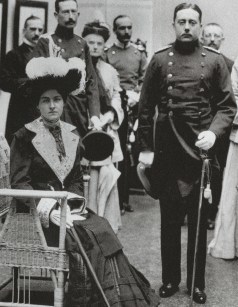 Caroline (seated) and her husband (public domain)
Caroline (seated) and her husband (public domain)Though faced with the separation of her much-beloved sister, Hermine’s memories of that day also focused on a man who towered above everyone else, the Emperor. Her uncle and guardian, who was hosting the wedding, promised to introduce her to him and young Hermine dutifully curtseyed to him. It was an unforgettable experience for her, but the Emperor paid little attention. She later said, “How could he have foreseen that this blushing little girl was his future wife? I stood there, frozen on the spot where the Emperor had received my greeting. The Emperor went on and chatted with my uncle.”
It wasn’t just Caroline who had doubts about the wedding. Wilhelm Ernst received a stern talking to from the Emperor, and he said, “Only love can turn a palace into a home. Caroline is like a little bird, fallen out of its nest. She will miss the sisters who loved her. It will take her some time before she learns to be at home on the cold parquet floor of your castle.” He then raised his voice and said, “You have given me an Oath of Allegiance, and I order you to marry tomorrow.” The wedding went ahead as planned.
Caroline remained deeply unhappy, took up smoking and barely ate. The unhappiness of her marriage consumed her body, and she was soon emaciated. On 17 January 1905, Hermine sat by her dying sister’s bedside. On top of everything, Caroline had fallen ill with influenza, and her weakened body simply could not fight the disease. Hermine wrote, “The attack was so violent that there was no hope of her recovery from the first. She received the tenderest care, but all effort was in vain. In her heart of hearts, she did not wish to live.”
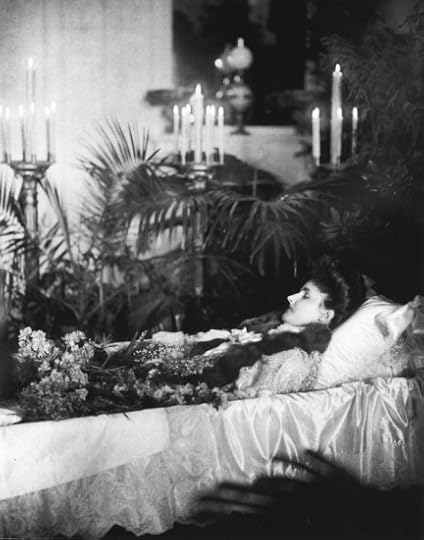 (public domain)
(public domain)Hermine would always remember that she first met her future husband at her sister’s wedding but mostly, she would remember the dear sister she lost.
The post Empress Hermine and the tragic wedding appeared first on History of Royal Women.
December 19, 2020
Abigail Campbell Kawānanakoa – A prominent Princess
Abigail Campbell Kawānanakoa was born on 1 January 1882 in the Campell House on Emma Street in Honolulu as the daughter of James Campbell, a wealthy industrialist from Ireland, and Abigail Kuaihelani Maipinepine Bright. Abigail was their eldest surviving daughter and one of the four (out of eight) surviving children of her parents.
Abigail was educated at private schools in Honolulu before she joined her father in California, where he was doing business. In California, she attended the College of Notre Dame, and she graduated in 1900. During this time, she converted from Protestantism to Catholicism. Her father – who was 32 years older than her mother – died in 1900 at the age of 74 and he had been one of the largest landowners in Hawaii, and thus he left a large estate.
In 1893, the Hawaiian Kingdom was overthrown, but Abigail still received the courtesy title of Princess when she married Prince David Laʻamea Kahalepouli Kinoiki Kawānanakoa – the son of Victoria Kinoiki Kekaulike – on 6 January 1902. He had been granted the title of Prince and style of His Royal Highness in 1883 by King Kalākaua, and he was declared the third heir – after then princess Liliʻuokalani and princess Kaʻiulani – to the throne. Abigail married David at the Occidental Hotel in a ceremony performed by Archbishop Riordan. Her mother made sure Abigail’s assets were protected as David was known to be a spendthrift, and he had agreed to a prenuptial agreement. Abigail’s mother had remarried to Colonel Samuel Parker in the same hotel just two days before.
Abigail and David went on to have three children together: Abigail (1903), David (1904) and Lydia (1905), but it was to be a short marriage. Prince David died of pneumonia on 2 June 1908 – he was still only 41 years old. He had converted to Catholicism a year before his death. Prince David left his estate to his son David and daughter Lydia. The eldest daughter was probably left out as she was one of the heirs of her grandmother – having been officially adopted by her the same year of her father’s death.
There was more heartbreak to come for the elder Abigail. Not only did she lose her husband, but her mother also died that same year in October – of heart failure following a breast cancer operation. The Campbell estate was worth 3 to 4 million dollars, and her mother held a lifetime interest in it, and she was entitled to one-half of the income, while the other half was divided among her four daughters. Her half reverted to the estate upon her death, and the income was divided among her heirs. In addition, she also left a large estate, independent of her first husband’s estate, and it was her granddaughter Abigail who was one of the heirs of this estate.
Unfortunately, not much is known of the elder Abigail’s life from 1909 until 1924. She was reportedly booked to travel on the Titanic but cancelled her booking before the sailing. She would later organise a collection that raised some $1,000 from the women of Hawaii, which was given to the Women’s Titanic Memorial Association. She became more politically after 1922, upon the death of Prince Jonah Kūhiō Kalanianaʻole, her brother-in-law. Abigail was a Republic like him and her stepfather Samuel Parker, and she was a keen party worker. Abigail became the first woman from Hawaii to serve on the party’s national committee and stayed on from 1924 until 1936. She first registered to vote on 8 February 1922, following the passage of the 19th amendment of the United States Constitution. She was an active supporter of women’s rights in Hawaii and was an advocate for jury service for women. After her brother-in-law’s death, she effectively became the leader of the Native Hawaiian community, and she often acted as an official hostess for visiting dignitaries.
In 1933, her son David was convicted of the manslaughter of a young woman named Felicity Connors due to reckless driving, and he was given a suspended sentence. In 1937, his common-law wife Arvilla Kinslea was found stabbed in the neck. He was in violation of his probation by even living with her and was quickly arrested.1 He eventually pled guilty to manslaughter and was sentenced to ten years which would run consecutively with the suspended sentence of the Felicity Connors manslaughter.2 It is unclear when he was released, but his obituary later stated he served in the United States Navy and the Coast Guard during the Second World War, making it unlikely that he served the full ten years.
In 1936, the Paradise of the Pacific noted: “Much as a loving and beloved queen champions the welfare of her devoted subjects and loyal admirers, Princess Kawananakoa has many a time and oft interceded for the humbler citizen in the now complicated and more or less mysterious American political game which became part of one-time royal Hawaii’s simple and happy (if not always scientific) government.”3
During the Second World War, Abigail lent her beach house to the United Service Organisation for use as a recreation centre for the American armed forces and also leased her home in Honolulu to the Service Women’s Club. Unfortunately, she did not live to see the end of the war – she died in Honolulu on 12 April 1945. She was interred in the Mauna ʻAla Royal Mausoleum three days later beside her husband. During the service Edward Kahale, pastor of the Kawaiaha’o Church said, “Within her great and generous heart, within her amazing breadth of mentality, her infinite sympathy, her dauntless courage and her unshakable constancy in the wise leadership of the people of her race lay her most significant patent of royalty; hers by Divine inspiration.”4 The Senate of the Territory of Hawaii passed Senate Resolution 46 on 16 April and honoured her by noting, “in her death, Hawaii has lost the last link with the Hawaiian Crown.”5
Through her two daughters, she had four grandchildren.6
The post Abigail Campbell Kawānanakoa – A prominent Princess appeared first on History of Royal Women.
December 18, 2020
Book News January 2021
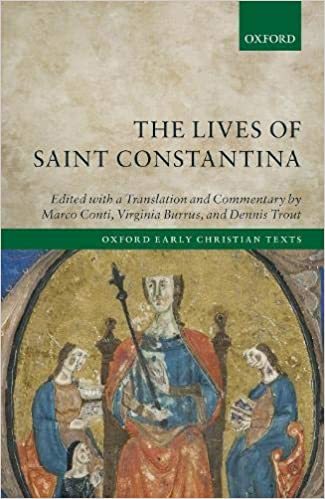
The Lives of Saint Constantina: Introduction, Translations, and Commentaries (Oxford Early Christian Texts)
Hardcover – 4 November 2020 (UK) & 4 January 2021 (US)
Constantina, daughter of the fourth-century emperor Constantine who so famously converted to Christianity, deserves a place of her own in the history of Christianity. As both poet and church-builder, she was an early patron of the Roman cult of the virgin martyr Agnes and was buried ad sanctam in a sumptuously mosaicked mausoleum that still stands. What has been very nearly forgotten is that the twice-married Constantina also came to be viewed as a virgin saint in her own right, said to have been converted and healed of leprosy by Saint Agnes. This volume publishes for the first time critical editions and English translations of three Latin hagiographies dedicated to the empress, offering an introduction and commentaries to contextualize these virtually unknown works.
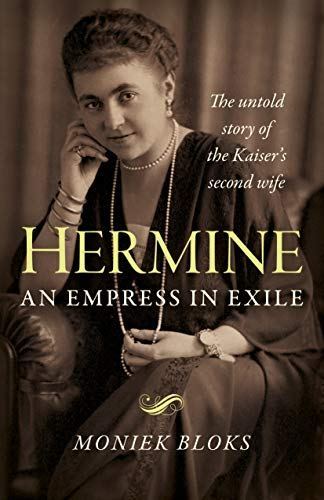
Hermine: an Empress in Exile: The untold story of the Kaiser’s second wife
Paperback – 1 January 2021 (US) & 11 December 2020 (UK)
Hermine Reuss of Greiz is perhaps better known as the second wife of the Kaiser (Emperor Wilhelm II of Germany) whom she married shortly after the death of his first wife Auguste Viktoria and while he was in exile in the Netherlands. She was by then a widow herself with young children. She was known to be ambitious about wanting to return to power, and her husband insisted on her being called ‘Empress’. To achieve her goal, she turned to the most powerful man in Germany at the time, Adolf Hitler. Unfortunately, her dream was not realised as Hitler refused to restore the monarchy and with the death of Wilhelm in 1941, Hermine was forced to return to her first husband’s lands. She was arrested shortly after the end of the Second World War and would die under mysterious circumstances while under house arrest by the Red Army.
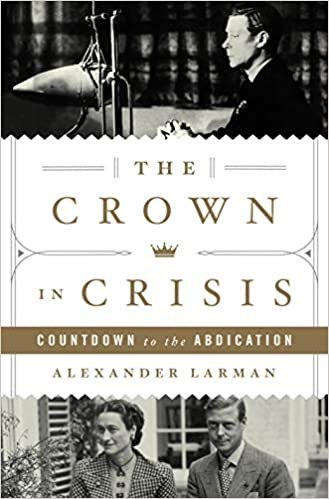
The Crown in Crisis: Countdown to the Abdication
Hardcover – 19 January 2021 (US & UK)
Alexander Larman’s The Crown in Crisis will treat readers to a new, thrilling view of this legendary story. Informed by revelatory archival material never-before-seen, as well as by interviews with many of Edward’s and Wallis’s close friends, Larman creates an hour-by-hour, day-by-day suspenseful narrative that brings readers up to the point where the microphone is turned on and the king speaks to his subjects. As well as focusing on King Edward and Mrs. Simpson, Larman looks closely at the roles played by those that stood against him: Prime minister Stanley Baldwin, his private secretary Alec Hardinge, and the Archbishop of Canterbury Cosmo Lang. Larman also takes the full measure of those who supported him: the great politician Winston Churchill, Machiavellian newspaper owner Lord Beaverbrook, and the brilliant lawyer Walter Monckton.
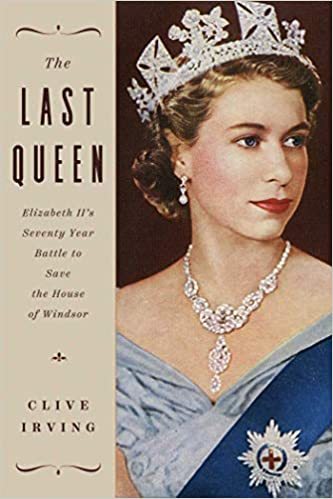
The Last Queen: Elizabeth II’s Seventy Year Battle to Save the House of Windsor
Hardcover – 5 January 2021 (US & UK)
Clive Irving’s stunning new narrative biography The Last Queen probes the question of the British monarchy’s longevity. In 2021, the Queen Elizabeth II finally appears to be at ease in the modern world, helped by the new generation of Windsors. But through Irving’s unique insight there emerges a more fragile institution, whose extraordinarily dutiful matriarch has managed to persevere with dignity, yet in doing so made a Faustian pact with the media.
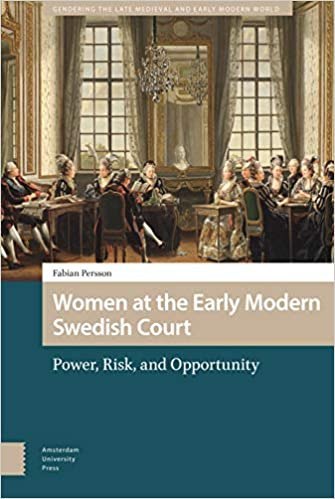
Women at the Early Modern Swedish Court: Power, Risk, and Opportunity (Gendering the Late Medieval and Early Modern World)
Hardcover – 27 January 2021 (US & UK)
What was it possible for a woman to achieve at an early modern court? By analysing the experiences of a wide range of women at the court of Sweden, this book demonstrates the opportunities open to women who served at, and interacted with, the court; the complexities of women’s agency in a court society; and, ultimately, the precariousness of power. In doing so, it provides an institutional context to women’s lives at court, charting the full extent of the rewards that they might obtain, alongside the social and institutional constrictions that they faced. Its longue durée approach, moreover, clarifies how certain periods, such as that of the queens regnant, brought new possibilities. Based on an extensive array of Swedish and international primary sources, including correspondence, financial records and diplomatic reports, it also takes into account the materialities used to create hierarchies and ceremonies, such as physical structures and spaces within the court. Comprehensive in its scope, the book is divided into three parts, which focus respectively on outsiders at court, insiders, and members of the royal family.
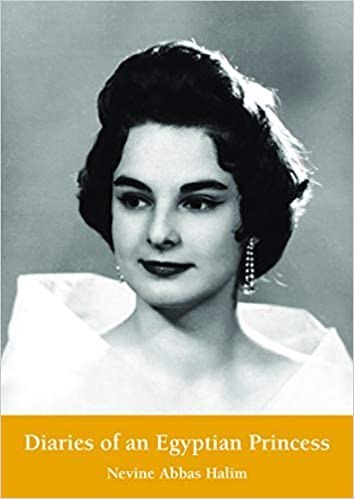
Diaries of an Egyptian Princess
Hardcover – 1 January 2021 (UK) & 14 April 2020 (US)
Princess Nevine Halim is a direct descendant of the royal family that ruled Egypt from 1805 until the abdication of King Farouk in the wake of the Free Officers coup in 1952. The eldest of three children, she was born in Alexandria on 30 June 1930, the great-great-granddaughter of Muhammad Ali Pasha on her father’s side and the great-granddaughter of Khedive Ismail on her mother’s side.
Drawing on her own diary, as well as those of her mother and grandmother, she takes us on a journey from the First to the Second World War, from Egypt to Europe and the United States, from a world of glamour, wealth, and privilege to the fugitive existence of the exile and social outcast after 1952. We also meet her father, Abbas Halim, the charming rebel prince who clashed with King Fuad for championing the rights of workers, as well as many other members of the Egyptian royal family and a glittering host of international royals, politicians, and film stars.
Packed with royal gossip and political intrigue, with tales of young love and fashionable society, and of princes and princesses dancing perilously close to the edge of a way of life that would one day fall apart and then vanish, Diaries of an Egyptian Princess is an event-filled account of an endlessly fascinating epoch in modern Egyptian history.
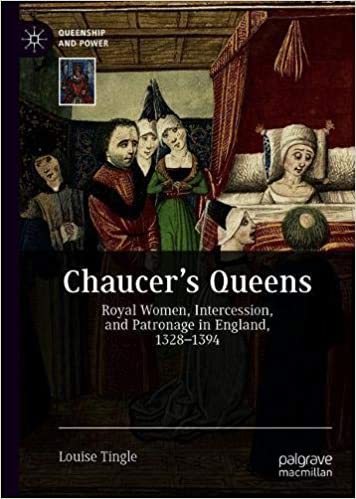
Chaucer’s Queens: Royal Women, Intercession, and Patronage in England, 1328–1394 (Queenship and Power)
Hardcover – 30 January 2021 (UK & US)
This book investigates the agency and influence of medieval queens in late fourteenth-century England, focusing on the patronage and intercessory activities of the queens Philippa of Hainault and Anne of Bohemia, as well as the princess Joan of Kent. It examines the ways in which royal women were able to participate in traditional queenly customs such as intercession, and whether it was motherhood that gave power to a queen. This study focuses particularly on types of patronage, and also considers the importance of coronation, especially for Joan of Kent, who was neither a queen consort nor a dowager, yet still fulfilled some queenly duties. Crucially, the author highlights the transactional nature of the queen’s role at court, as she accumulated wealth from land, rights and traditions, which in turn funded patronage activities.
[no image yet]
Sister-Queens in the High Hellenistic Period: Kleopatra Thea and Kleopatra III (Routledge Studies in Ancient History)
Hardcover – 1 January 2021 (UK)
The post Book News January 2021 appeared first on History of Royal Women.
December 17, 2020
The Time Traveller’s Guide to Regency Britain by Ian Mortimer Book Review
The Time Traveller’s Guide to Regency Britain is the fourth book of its kind to be written by Ian Mortimer. The previous books have been on Medieval England, Elizabethan England and Restoration Britain, there is certainly no need to read the others before reading this one though as they do not lead into each other.
If you have read one of these then you will have an idea on what to expect, if not; the books are written as if you have gone back in time and are actually visiting a certain time period. The reader is addressed as though they are a traveller visiting Regency Britain and the book guides you around Great Britain and Ireland with hints and tips of what to do and see.
There is in-depth information on many locations as well as how you should travel from place to place, where to stay on your journey, regional food and drink and even local dialects. If you are used to a more traditional history book then the format seems a little strange at first and rather casual, but try not to let it put you off; this book and the other Time Traveller’s Guides contain so much great information. In amongst some of the more entertaining aspects of Regency life and funny stories you will find a book jam-packed with information on life-expectancy rates in different areas (an average of around 20 in certain industrial towns!), statistics on population growth, an insight into women’s rights and information on widespread changes in technology, to name just a few. This wealth of facts is sprinkled in amongst great story-telling so that you barely notice how much you have learned until a chapter is finished.
The Regency or Georgian Period which was from roughly 1790-1830 is an often-romanticised period of British history; an era of fun and frivolity, parties and excess before Victorian morality and mass industrialisation. This book does show some of this side of the Regency era; especially in its depictions of King George IV, but we get to also see how the other half lived. With a rapidly growing population which caused inflated food costs and land-enclosures causing the poor to flock to cities. We also glimpse at the lives of the ‘destitute’, the horrors of the workhouse and how rural Highland communities struggled to survive.
This book and the others by Ian Mortimer are very well-researched and beautifully written, I’d recommend this to anyone with an interest in the period or anyone who doesn’t know anything about it, as you certainly will after reading it!
I will say that the book is pretty large, but because it is broken down into many sections you can read little bits when you feel like it. There are some sections which seem like they are going to be a bit boring; I didn’t really want to read the section on the landscape of London for example, but I did and I am glad as it was really eye-opening! This one comes highly recommended and would also make a great Christmas gift.
The Time Traveller’s Guide to Regency Britain by Ian Mortimer is available now in both the UK and the US.
The post The Time Traveller’s Guide to Regency Britain by Ian Mortimer Book Review appeared first on History of Royal Women.



